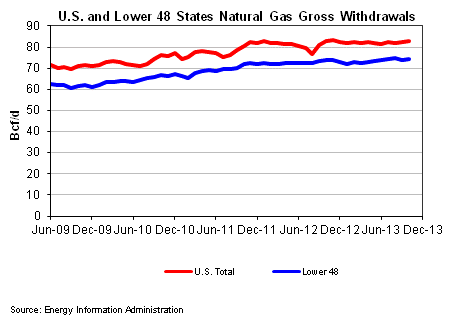E&P | NGI All News Access | NGI The Weekly Gas Market Report
EIA Reports Renewed Production Strength in October
U.S. natural gas production, which had seen an uncharacteristic stumble in September, recovered in October, with the shale-rich “Other States” category once again helping to push the national total higher, according to the Energy Information Administration’s (EIA) Monthly Natural Gas Gross Production Report.

Total U.S. natural gas production in October was 83.03 Bcf/d, a 0.83 Bcf/d increase from September and a 0.56 Bcf/d more than in October 2012, EIA said. It was the highest national total on record, according to EIA data, surpassing the 82.95 Bcf/d recorded in January 2012.
The U.S. total got a boost from the Other States category, which includes Pennsylvania, Ohio and West Virginia. Production in the category was 27.29 Bcf/d in October, up from 26.63 Bcf/d in September and 23.57 Bcf/d in October 2012. The increase in Other States came “as many operators reported new wells in the Marcellus Shale play,” EIA said.
In the previous EIA production report, the Other States category had been down compared to the previous month for only the second time in nine months (see Daily GPI, Dec. 9, 2013).
Also showing production increases in October were New Mexico (3.68 Bcf/d, compared with 3.65 Bcf/d in September), Wyoming (5.70 Bcf/d, compared with 5.28 Bcf/d in September) and Alaska (8.43 Bcf/d, compared with 8.25 Bcf/d in September). Production in Texas was 22.76 Bcf/d in October, unchanged from the previous month. The Lower 48 total was 74.60 Bcf/d in October, a 0.65 Bcf/d increase from September.
Month-to-month declines were reported in only three categories: Federal Offshore Gulf of Mexico (3.32 Bcf/d in October, compared with 3.55 Bcf/d in September), Louisiana (5.86 Bcf/d, compared with 6.08 Bcf/d) and Oklahoma (5.99 Bcf/d, compared with 6.00 Bcf/d). Declines in the Gulf and Louisiana were due primarily to “equipment and facility maintenance, normal well decline and Tropical Storm Karen [see Daily GPI, Oct. 7, 2013],” according to EIA.
The broad production recovery is likely to show a further spike when EIA reports estimates for November, according to Barclays Capital analysts Biliana Pehlivanova and Shiyang Wang.
“November saw several key pipeline expansions that came online and debottlenecked Marcellus production,” the analysts said in a note. “December production, on the other hand, will likely show a large, but temporary, drop as maintenance and well freeze-offs curtail output…although the extremely cold temperatures in the Rockies and the Southwest will likely continue to curtail production in the near term, we expect production growth to accelerate later in the year.”
In the first Short-Term Energy Outlook (STEO) to include forecasts for 2015, EIA predicted U.S. natural gas output this year would increase on average about 2.1% from 2013 (see Daily GPI, Jan. 7). Widespread freeze-offs occurred last month, disrupting production for several days across the Piceance, Uinta, San Joaquin and Williston basins, and leading to the largest storage withdrawal for the week ending Dec. 13 since recordkeeping began in 1994, STEO said. And a recent analysis by Raymond James & Associates Inc. concluded that natural gas-directed drilling, which was at its lowest average in more than 20 years in 2013, should increase in 2014 on Northeast expansions alone, the first gains in the onshore since 2010 (see Daily GPI, Dec. 24, 2013).
EIA also issued revised production figures for a several categories with the monthly report. The agency reported revised numbers for August for Texas (22.93 Bcf/d), Lower 48 (74.68 Bcf/d) and U.S. Total (82.14 Bcf/d), and September for Louisiana (6.08 Bcf/d), Oklahoma (6.00 Bcf/d), Texas (22.76 Bcf/d), Other States (26.63 Bcf/d), Lower 48 (73.95 Bcf/d) and U.S. Total (82.20 Bcf/d).
© 2024 Natural Gas Intelligence. All rights reserved.
ISSN © 1532-1231 | ISSN © 2577-9877 | ISSN © 1532-1266 |
